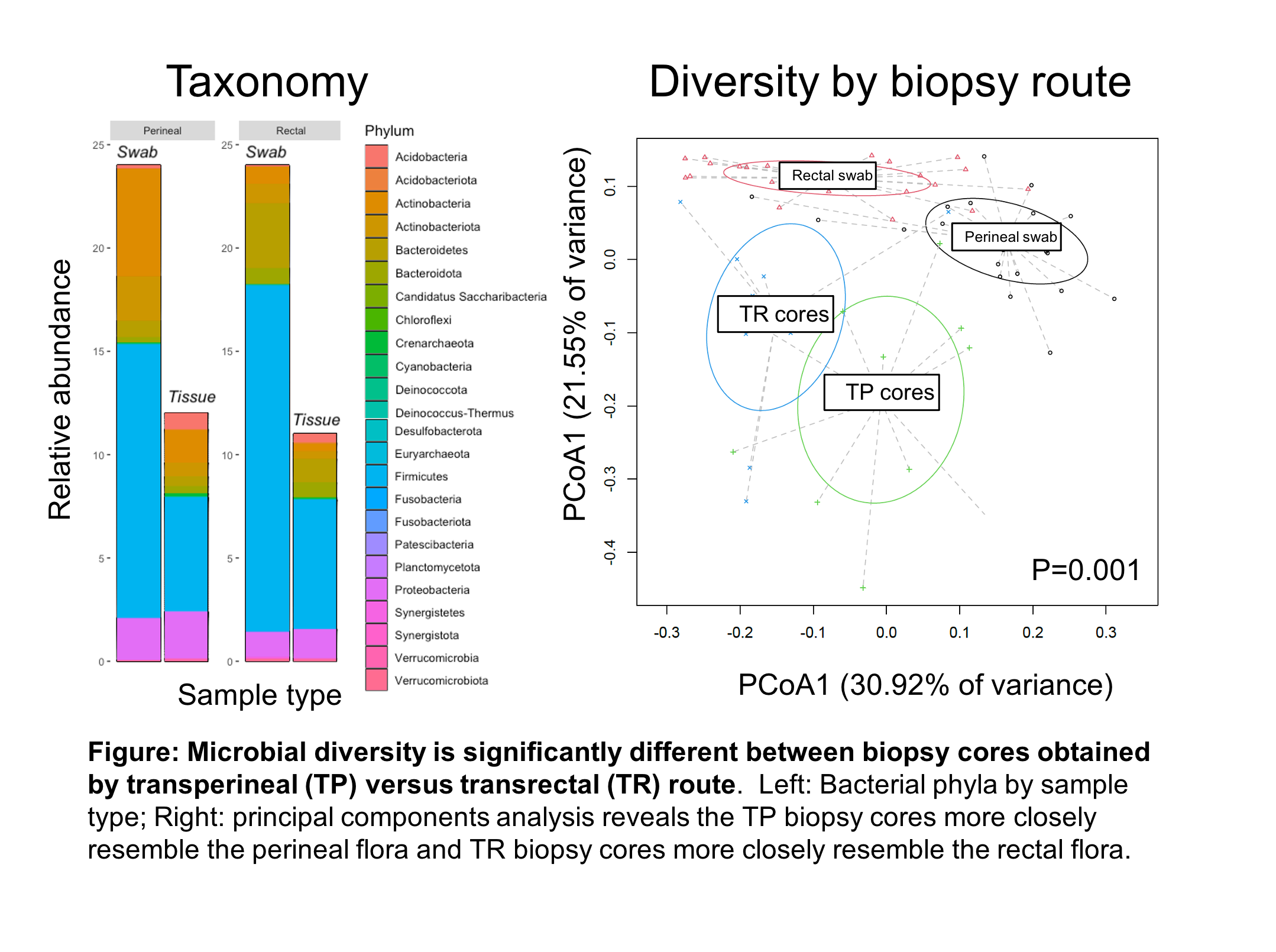Back
Poster, Podium & Video Sessions
Moderated Poster
MP37: Infections/Inflammation/Cystic Disease of the Genitourinary Tract: Prostate & Genitalia
MP37-09: Prostate biopsy tissue cores obtained from the transperineal approach harbor fewer microbial species and lower microbial resemblance to the rectal flora relative to those obtained transrectally
Sunday, May 15, 2022
7:00 AM – 8:15 AM
Location: Room 225
Glenn T. Werneburg*, Aaron Miller, Ava Adler, Samuel Haywood, Eric A. Klein, Cleveland, OH

Glenn T. Werneburg, MD, PHD
Cleveland Clinic
Poster Presenter(s)
Introduction: Transperineal (TP) prostate biopsy for prostate cancer detection has generated renewed interest because it is associated with lower risk of postprocedural sepsis relative to transrectal (TR) biopsy. To understand the mechanism of this phenomenon, we sought to analyze microbial flora from biopsy tissue cores obtained from each route. We hypothesized that TP biopsy cores would bear lower resemblance to the rectal flora and be less likely to harbor pathogenic bacteria than those obtained via the TR route.
Methods: Participants were identified and consented per IRB-approved protocol. Perineal and rectal swabs were obtained from all participants for 16s next-generation sequencing (NGS). Additional prostatic biopsy cores were obtained for study use for NGS and standard culture. Comparisons between biopsy core microbial composition by route of biopsy and perineal/rectal flora were performed using principal components analyses with t-test and ANOVA.
Results: 23 participants (12 TP; 11 TR) were included. The TP and TR groups did not differ in age, race, grade group, or prior biopsy number. No TP participants, and all TR participants, received periprocedural antibiotics. No TP, and 1 TR, participant developed infection-related complication. Biopsy cores obtained via TP route had a lower proportion of Firmicutes and Bacteroidetes (Figure left), fewer species (p=0.00001) and less diversity (p=0.001) than the TR route. Cores via TR route more closely resembled rectal flora than those from TP route (p=0.001, Figure right). There was a trend toward increased sequencing depth in the TR group cores, consistent with higher overall biomass.
Conclusions: Tissue obtained via TP route, despite no periprocedural antibiotics, exhibited lower proportions of Firmicutes and Bacteroidetes, lower resemblance to rectal flora, and fewer bacterial species relative to tissue obtained from TR route. Our results suggest there is less introduction of pathogenic flora into prostatic tissue via TP relative to TR approach. These findings likely account for the substantially lower risk of sepsis in TP biopsy, and support widespread adoption of the TP approach, which minimizes sepsis risk and improves antibiotic stewardship.
Source of Funding: N/A

Methods: Participants were identified and consented per IRB-approved protocol. Perineal and rectal swabs were obtained from all participants for 16s next-generation sequencing (NGS). Additional prostatic biopsy cores were obtained for study use for NGS and standard culture. Comparisons between biopsy core microbial composition by route of biopsy and perineal/rectal flora were performed using principal components analyses with t-test and ANOVA.
Results: 23 participants (12 TP; 11 TR) were included. The TP and TR groups did not differ in age, race, grade group, or prior biopsy number. No TP participants, and all TR participants, received periprocedural antibiotics. No TP, and 1 TR, participant developed infection-related complication. Biopsy cores obtained via TP route had a lower proportion of Firmicutes and Bacteroidetes (Figure left), fewer species (p=0.00001) and less diversity (p=0.001) than the TR route. Cores via TR route more closely resembled rectal flora than those from TP route (p=0.001, Figure right). There was a trend toward increased sequencing depth in the TR group cores, consistent with higher overall biomass.
Conclusions: Tissue obtained via TP route, despite no periprocedural antibiotics, exhibited lower proportions of Firmicutes and Bacteroidetes, lower resemblance to rectal flora, and fewer bacterial species relative to tissue obtained from TR route. Our results suggest there is less introduction of pathogenic flora into prostatic tissue via TP relative to TR approach. These findings likely account for the substantially lower risk of sepsis in TP biopsy, and support widespread adoption of the TP approach, which minimizes sepsis risk and improves antibiotic stewardship.
Source of Funding: N/A


.jpg)
.jpg)